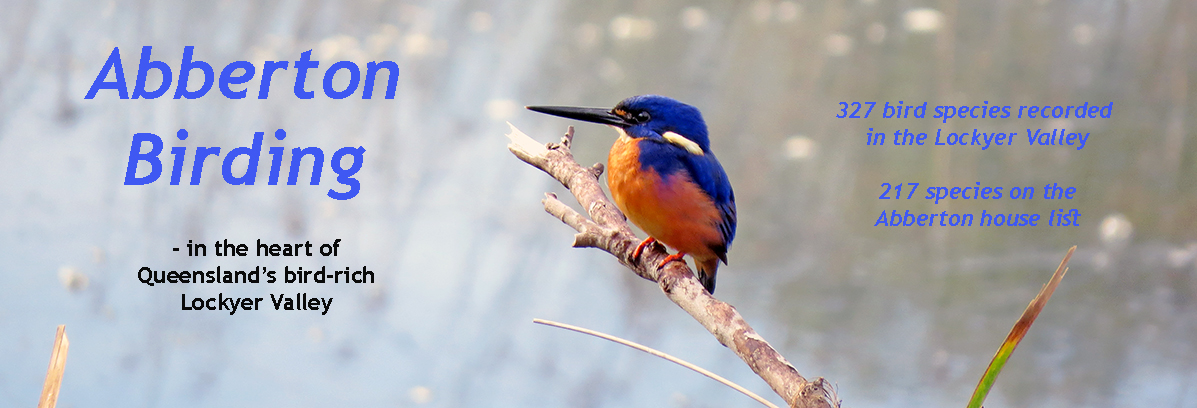16 December, 2005
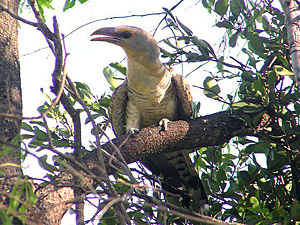
An immature Channel-billed Cuckoo -
raised by Torresian Crows and now trying to fend for itself.
|
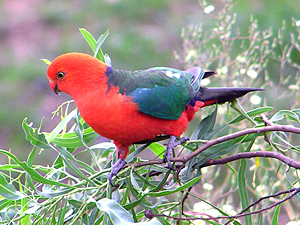
|

|
|
A splendid
male King Parrot in a young Acacia salicina was the first bird I saw when
I stepped onto the verandah around 6 o'clock this-morning.
|
|
|
15 December, 2005 -
A moment of excitement!
Sitting
quietly at my desk a few minutes ago, then a moment later yelling out to
Eileen
"New bird for Abberton" and reaching for the camera and binoculars
at the same time
as we both race out to the verandah to look at two beautiful little parrots!
|

|

|
Musk Lorikeets - just
outside my window
In fact, Musk Lorikeet has been here just once before, in January 2003, but
these views were so good
it felt like a new bird at the time, and had all the excitement of a new
bird for the garden.
Musk Lorikeets are common
enough up the range in Toowoomba, but very scarce down here in the valley.
Most of our eucalypts here are in full flower at the moment, so I guess that
is what has pulled them in
to join our regular Scaly-breasted Lorikeets and less frequent Little
Lorikeets.
Around dusk every night
there is a change of shifts, and these warm summer evenings are full of the
sounds
of Flying Foxes feeding and squabbling right alongside the house in the same
trees that
the lorikeets feast in during the day.
|
|
|
December, 2005
|

|
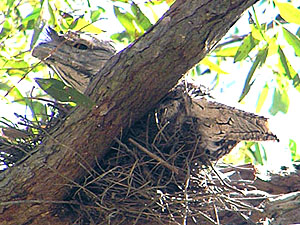
|
Even on a good day, an Apostlebird can look
like
it's been dragged through a hedge backwards
|
Tawny Frogmouth sitting on young in the
nest
- at Helidon
|
|
|
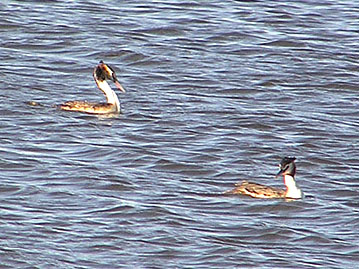
|
Lake Dyer held at least 13 Great-crested
Grebes on 10 December
|
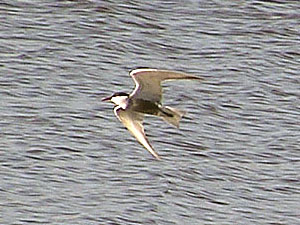
|
|
and a host of Whiskered Terns
|
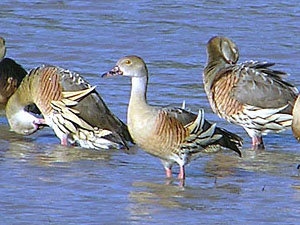

|
Nearby were Plumed Whistling Ducks, and Royal Spoonbill
|
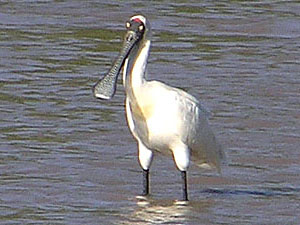
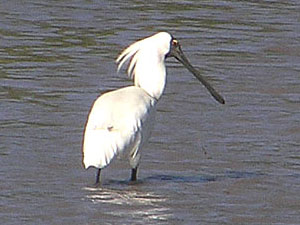
|
|
|

|
|
and two Pink-eared Duck and a Wandering
Whistling Duck.
|
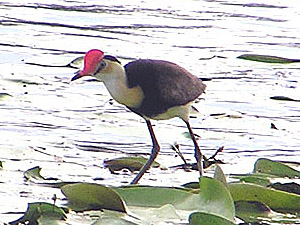
|

|
|
Comb-crested Jacana
|
Magpie Goose
|
Two common waterbirds in the area - neither is on our house-list yet,
but they're easy enough to find
nearby.
|
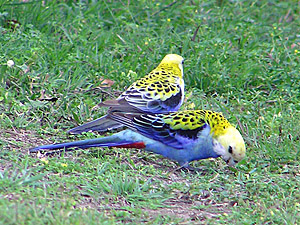
|
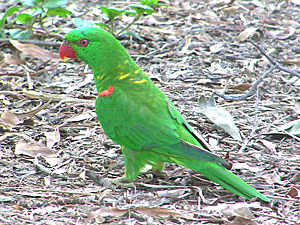
|
|
Pale-headed Rosellas
|
Scaly-breasted Lorikeet - one of the
four
lorikeet species that visit us
|
|
|
Spring
2005
|
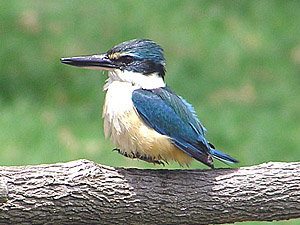
click image to enlarge
|
|
Sacred Kingfisher coming in to land!
|

|

click image to enlarge
|
|
Laughing Kookaburra
|
Noisy Friarbird
|
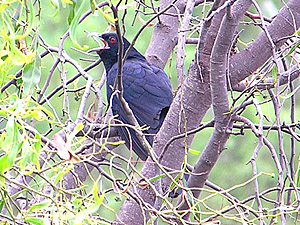
|

|
|
A Common Koel doing his noisy thing
|
Diamond Dove an unusual visitor to our
garden
|
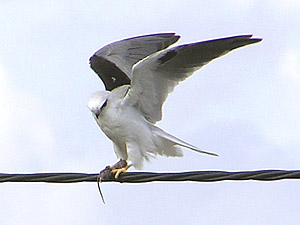
click image to enlarge
|
|
Black-shouldered Kite
|
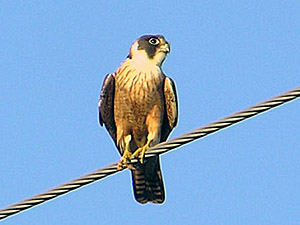
|

|
|
Australian Hobby
|
Peregrine Falcon at nest in nearby Toowoomba
- calling to a straying chick
|

|
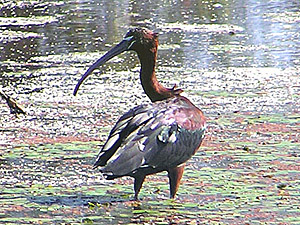
click image to enlarge
|
|
Red-capped Dotterel
|
A particularly smart Glossy Ibis
|
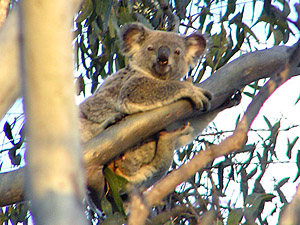
|
|
Koala in the forest nearby
|
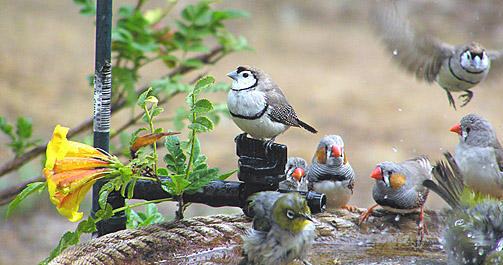
|
|
Double-barred Finches, Zebra Finches and
Silvereyes at a birdbath
|

click image to enlarge
|
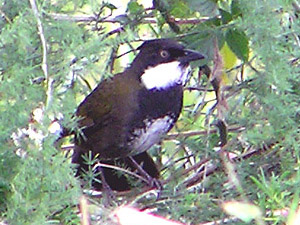
|
|
Rufous Fantail - a summer visitor to our
garden
|
Eastern Whipbird - not always hard to see
|
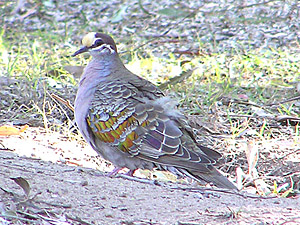
|
|
Male Common Bronzewing, showing his golden
yellow forehead
|
|
|
August, 2005 -
Birds everywhere!
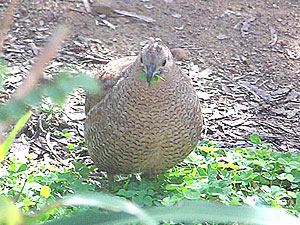
Brown Quail, photographed through a window.
We seem to
be surrounded by Brown Quail at present!
It's not unusual to see them here, but I just
replaced all the windows along one side
of the house with larger panes of
clear glass, and we're beginning to realise that the
quail are on one
side or other of the house, or under it, pretty well all day every day.
We've hardly had a winter, and the place is generally alive with
birds.
As I write, I can see Chestnut-breasted Mannikins and Zebra Finches on the
ground
outside my window, and two Speckled Warblers are bathing in the pool on the
rock nearby.
Striated Pardalotes and a Mistletoebird are calling, and a Wedge-tailed
Eagle is
soaring way up overhead.
I'll be glad to finish this and get outside to see what else is about!
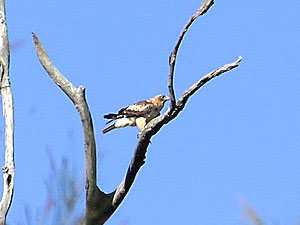
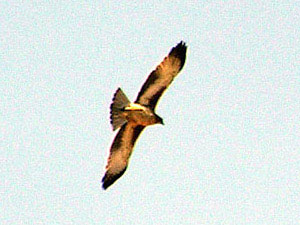
Little Eagle, a fairly regular winter visitor here, first spotted in a
tree across the creek,
and shortly after showing its distinctive underwing in flight.
|
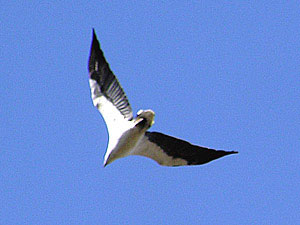
White-bellied Sea-eagle
|
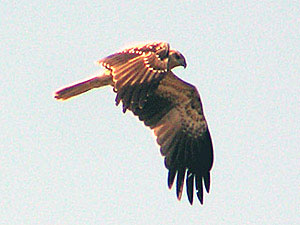
Whistling Kite
|
|
Two more raptors distinctive in flight - both
photographed at Abberton.
|
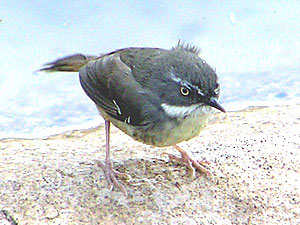
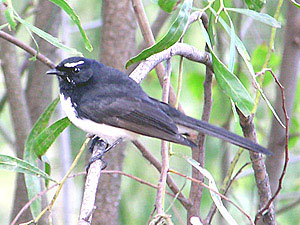
The diminutive, always busy, White-browed Scrubwren, and the equally busy
Willie Wagtail are usually the last two birds active in the garden late in
the day.
|
|
|
15
June 2005 - Western Gerygone, Plumheads and more
Western
Gerygone is only a very occasional winter bird here, but we have had two at
Abberton for a
week or so. They sing quite a lot, and really do sound rather like a
White-throated Gerygone
suddenly running into a brick wall just before the end of its song!

click image to enlarge
Male Rose Robin
Other
winter birds for us are turning up, such as Rose Robins, Yellow-faced
Honeyeaters
and buff-flanked Silvereyes from down South.

Speckled
Warblers are around the garden in numbers. I've counted as many as ten
spread around the place on just a short walk. The creek is for the most part
dry just now, and the Speckled Warblers are into it like cattle on the long
paddock.
There
have been plenty of Plumheaded Finches around the valley, and a couple
dropped into the garden on Sunday, which led me to wonder if they've maybe
recently
shifted their current roost closer to us, in which case we can look forward
to an influx
for a few weeks. Then last night, as we were sitting on the verandah not
long before
dusk, we saw the familiar sight (and heard the familiar sound) of small
parties of
Plumheads passing overhead on their way to roost. They were heading a bit
upstream
of the house, and I don't know whether the roost is on Abberton or not, but
they do
favour waterside vegetation for their roosts be it reedbeds or cane-grass or
whatever
- and there are plenty of options for them here.
Square-tailed Kite is pretty regular in May/June, and we had great views of
one low
and almost overhead as we drove in to Gatton the other day.
|
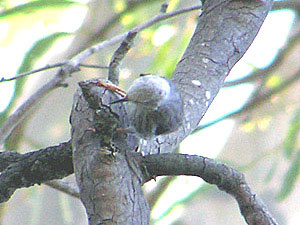

Varied Sittellas descend onto trees in
groups. Our Queensland race has a white head,
bright yellow feet, and orange wing-bars. They are the nearest thing
Australia has to a nuthatch,
but very much smaller.
|
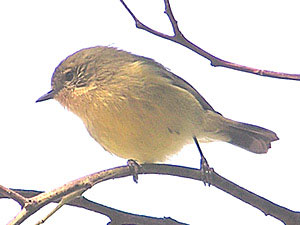
click image to enlarge
Yellow Thornbill
|

White-throated Gerygone
|
Three more of our garden birds.
Yellow Thornbill and White-throated
Gerygone (above) are just about everpresent.
Black-faced Monarch below is only an
occasional visitor to us.
|
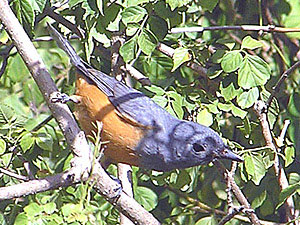
Immature Black-faced Monarch
|
|
|
|
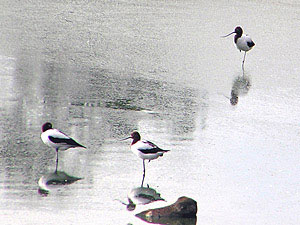
Red-necked Avocets
|

White-necked Heron
|
|
|
June
2005
|
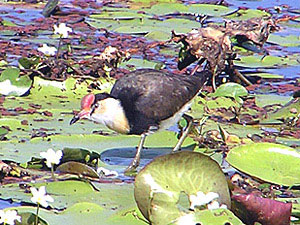
Comb-crested Jacana
|
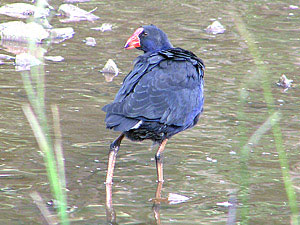
Purple Swamphen
|
|
Lake Freeman held a lot of good birds yesterday afternoon. I
found about 9 pairs of
Aussie Shoveler, 2 Freckled Duck, 3 pairs of Cotton Pygmy-goose along with
two full
grown imms, lots of Pink-eared Duck, hordes of Plumed Whistling-duck,
Chestnut Teal,
in fact 12 duck species in all as well as Magpie Geese and Black Swans with
young.
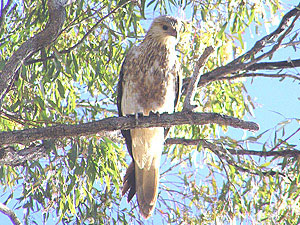

Whistling Kites
There were about a dozen Comb-crested Jacana, Glossy Ibis, herons,
spoonbills,
and 23 other waterbird species, as well as White-bellied Sea-eagle,
Whistling Kite,
Black-shouldered Kite, and lots more.
|
|
|
9
May 2005 - A lot going on
|

|
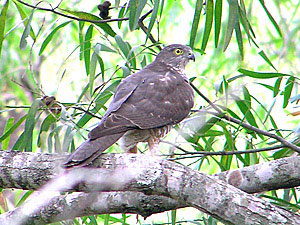
|
|
Collared Sparrowhawk in the garden
|
|
A Collared Sparrowhawk came down
to a birdbath on Saturday, and just sat there
for some time - as they do. Then she shifted into
an adjacent tree, allowing me to
take some photos from the fringes of the
house.
An
influx of Red-tailed Black Cockatoos yesterday afternoon - 30 or so.
They've just about cleaned out the fruit from the White Cedars, but they're
happy
to get stuck into the bigger eucalypts.
|
|
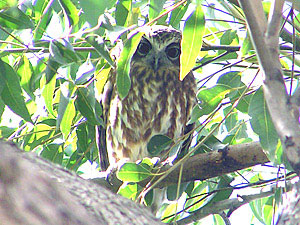
click image to enlarge
Friends Mark and Pauline, just up the road, have had a Southern Boobook in their
garden for several days.
It's become quite regular in its favourite tree.

Female Speckled Warbler
This-morning
we had five Speckled Warblers rummaging around the litter
that is our presently dry garden. Yellow-faced Honeyeaters have turned up,
as they
do every autumn, along with southern Silvereyes.
There are Rose Robins around in the valley, but none in the garden yet this
season.
|
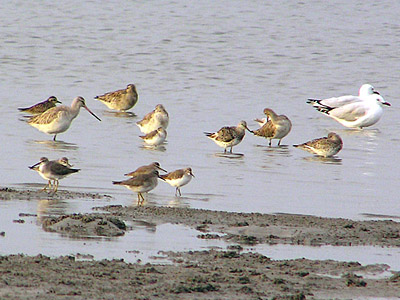
Pacific Golden Plover, Bar-tailed Godwit, Great Knot,
Grey-tailed Tattler, Curlew Sandpiper and Silver Gull
|
|
I spent a few days with a visitor from the US last week and between us we
turned up more than
160 spp, but that did include a couple of days outside the valley.
A very nice little group of waders at Thorneside included Pacific Golden
Plover,
Bar-tailed Godwits,
Great Knot, Grey-tailed Tattler, Terek Sandpiper and Curlew Sandpiper
- all neatly
juxtaposed for ease of
identification, with Black-winged Stilts and Silver Gulls
nearby to give
some size perspective,
and Collared Kingfishers dotted along the shore,
plus the most brilliantly
coloured Sacred Kingfisher I have ever seen - also sitting on the shoreline!
|

Curlew Sandpipers and Silver Gulls
|
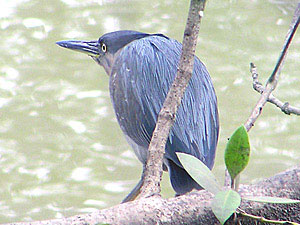
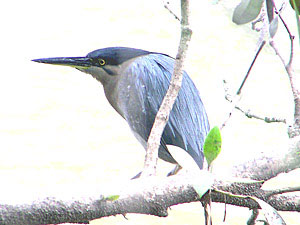
|
The same day, we found this Striated Heron
right alongside the Brisbane River.
|
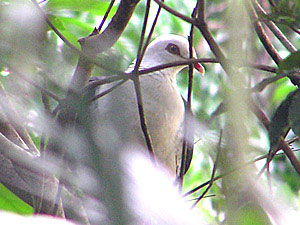
White-headed Pigeon at Mt Glorious
And, once again, Mt Glorious yielded the birds for which it is dependable,
including
Logrunner, Crested Shrike-tit, Noisy Pitta, Paradise Riflebird, Pale Yellow
Robin
and a range of fruit-doves and rainforest pigeons.
|
|
|
April
2005
|
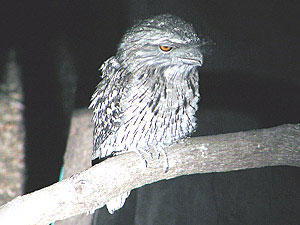
This Tawny Frogmouth came in to sit quietly on a rail
close by the house this-evening.
A couple of days ago, we were startled by
what appeared to be a Snow Bunting in the birdbath!
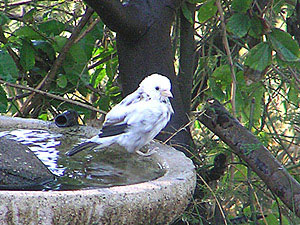
But, no it wasn't a new record for Australia
(or the Southern Hemisphere)
- it was just a leucistic House Sparrow.
|

Black-tailed Godwits on Lake Atkinson - providing
an interesting size comparison with the Black-winged Stilt
Black-tailed Godwits occur on our inland
lakes every spring and summer,
but I've yet to see a Bar-tailed Godwit away from the coast.
|
|
|
March,
2005
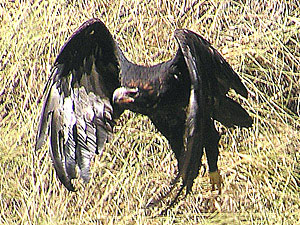

I was sitting at my desk when this Wedge-tailed Eagle landed under a tree
outside -
I tried to creep up on him, but this is as far as I got.

Welcome Swallow avoiding the heat of
the day under a Hotel's awning.
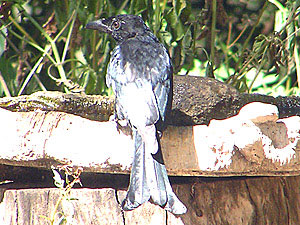

Spangled Drongo and Silvereyes
|
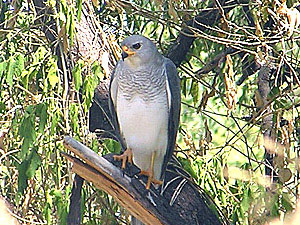
Grey Goshawk
A week or so back, a Grey Goshawk dropped
into a tree adjacent to the window
- we glanced at each other and it was gone. But, when I took a walk on
Easter Sunday,
there he was again, settled quietly and apparently comfortably in another
tree at
the other end of the garden.
|

Red-tailed Black Cockatoos were quiet here at
the beginning of the month,
but have recently reappeared in the garden in noisy feeding parties of up to
30 birds.
I guess they ate all the available ripe fruit last month, then gave us
a rest until some more matured.
Male bird above, and male and female
below.
|
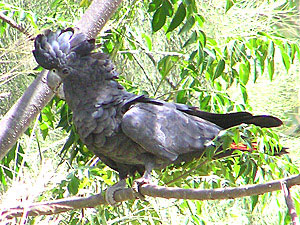
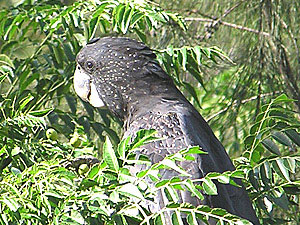
|
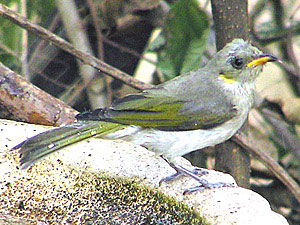
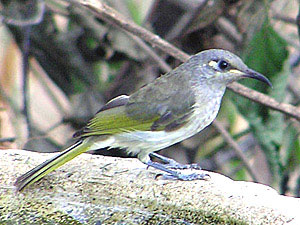
|
|
Fuscous Honeyeater (non-breeding)
|
Brown Honeyeater
|
Brown Honeyeaters are always here, but Fuscous has only turned up very
occasionally
at Abberton. The Fuscous above shows a lot of yellow on the base of the
lower mandible,
which is characteristic of non-breeding birds.
|
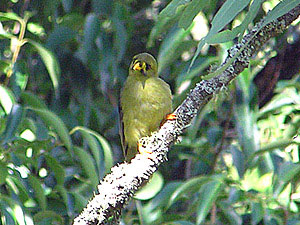
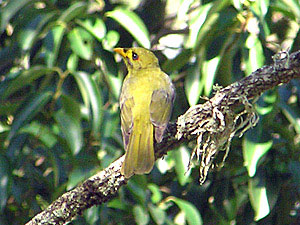
We often visit a nearby colony of Bell Miners. Like the Noisy Miner, they
are typically
intolerant of other birds, and whereas it's good to be able to see and hear
them
now and then, I wouldn't want them any closer to home.
|

This nocturnal Brush-tailed Possum was trying to sleep the day away in a
garden shed
|
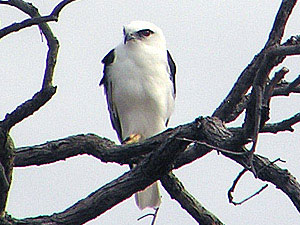
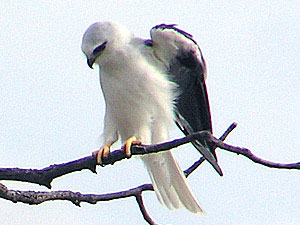
|
Two Black-shouldered Kites in the same
tree,
only a few minutes after seeing the Brown Falcon below.
|
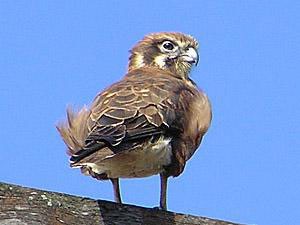

|
....and not far from what is probably Toowoomba's only resident Bush
Stone-curlew
- which is outside the fence in the photo, by the way.
|
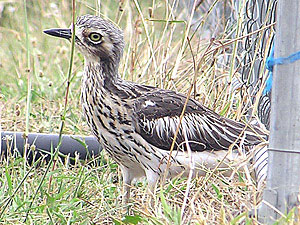
|

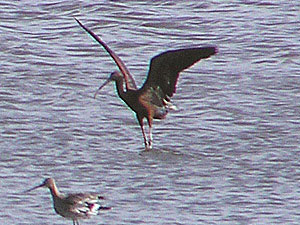
Glossy Ibis are ever-present around the valley these days.
The bird in the foreground (above right) is a Black-tailed Godwit - one of
12 at the same lake.
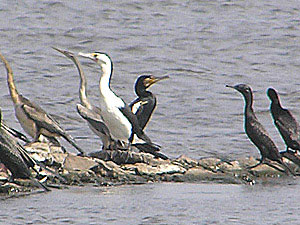
From the right: Two Little Black Cormorants, Great Cormorant,
Little Pied Cormorant (outlined against the wing of the Great
Cormorant),
Pied Cormorant and then several immature Darters
|
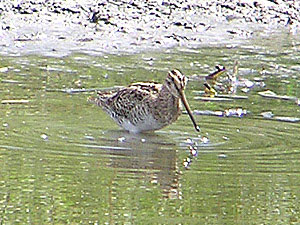
Latham's Snipe spends the northern winter here, but will be heading back
to Japan shortly.

Yellow-billed Spoonbill
In some parts of Australia, the Yellow-billed Spoonbill is scarcer than the
Royal Spoonbill,
but hereabouts you're just as likely to see one as the other - or both
together.
|

Two newly fledged Buff-banded Rails
- the bird in the front already showing the bold banding on the flanks, and
just the
beginning of the broad buff breast-band, while the other one is sporting
the
adult bird's typical big white eyestripe.

Red-kneed Dotterel at the same location
|
|
|
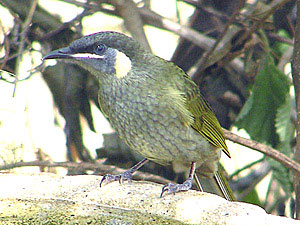
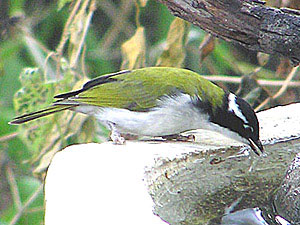
|
|
Lewin's Honeyeater
|
White-throated Honeyeater
|
Plenty of birds are coming to water during this current dry spell.
|

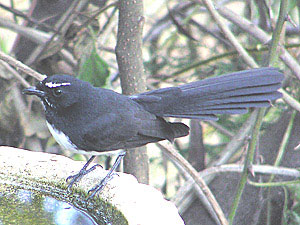
|
|
Grey Shrike-thrush
|
Willie Wagtail
|
|
...among them, this male Red-backed
Fairywren, who is in the process of losing his
summer finery, and entering eclipse plumage.
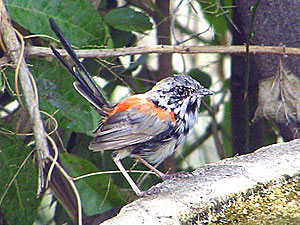
Red-backed Fairywren
|
Every summer for several years now,
White-browed Scrubwrens have been unable to resist
exploring a hanging pot on our main verandah, sometimes starting to bring
nesting material,
but never seeing it through, and usually nesting somewhere under the house.
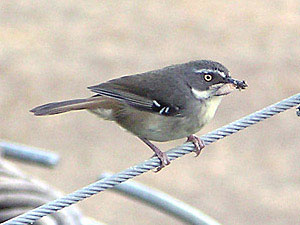
White-browed Scrubwren taking food to its nest
This year however, they persevered in building a bulky domed nest, just
skirting anyone
who happened to be on the verandah as they were coming and going, and
persevered -
successfully bringing three young birds out of the nest just a few days ago.
|
A big paddock of sunflower seeds just along
the road from here is a
good place to find parrots

Rainbow Lorikeet atop the sunflower,
Scaly-breasted Lorikeet and Galah looking on.
|

Jacky Winter, a typical flycatcher in lightly wooded parts
|
|
|
February,
2005
|
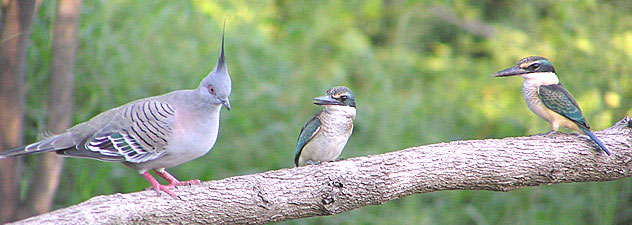
Crested Pigeon meets Sacred Kingfishers
|
|
|
|
|


Red-tailed Black Cockatoos continue to come
in to feed on the fruit of the White Cedars
|
|
|
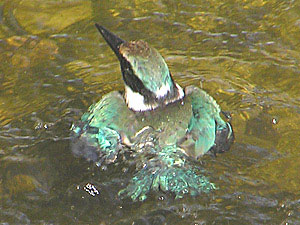
Sacred Kingfishers bathe a lot, then spend a
lot of time time preening nearby
|
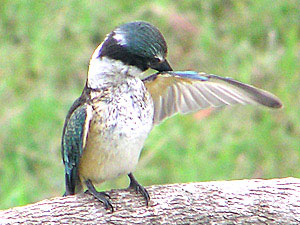
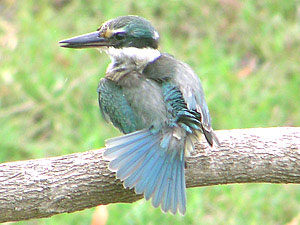
|

|
|
|

|
|
|
|
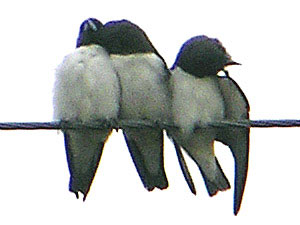
The most common Woodswallow in the valley is the White-breasted

White-throated Honeyeaters
(above and below)
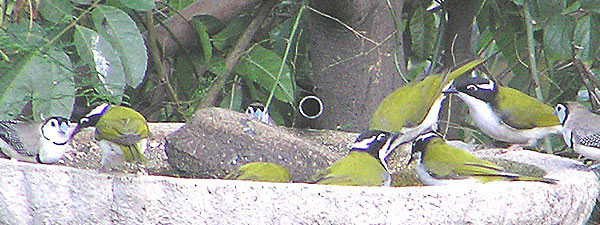
|
|
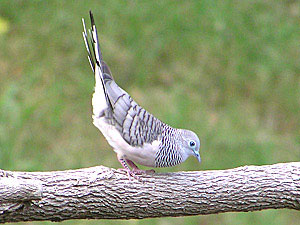
Male Peaceful Dove displaying
|
|

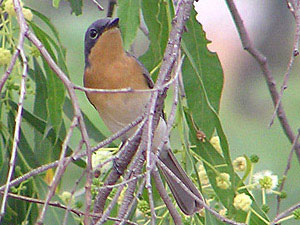
This bird is one of a group of four Myiagra flycatchers that spent a few
days here this month.
It isn't always a simple matter separating female Leaden and Satin
Flycatchers, but
after much soul-searching and consultation with friends and colleagues, I
can't find
anything definitive about these birds that marks them out as Satin
Flycatchers
- or anything that says that they couldn't be Leaden Flycatchers.
Leaden Flycatchers are regular here, Satin
Flycatchers are not.
The males are not so hard to tell apart.
|
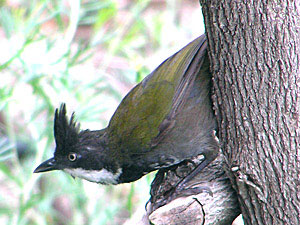
Eastern Whipbirds are thought of as somewhat secretive, but I'm not sure
that they are.
They lead their lives on and under thick undergrowth, which makes them hard
to see most of the time,
but here they are often seen in the open, albeit briefly, and they regularly
come to water
|
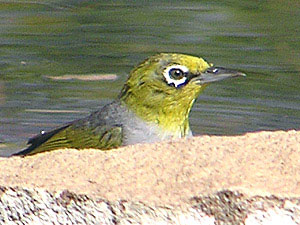

Two more regular bathers, Silvereye and Chestnut-breasted Mannikin
|
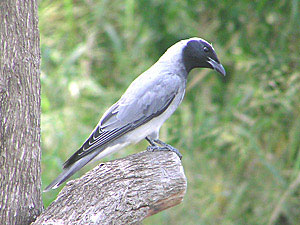
The Black-faced Cuckoo-shrike is such a handsome bird, but so common that
he gets overlooked.
I was surprised to discover just the other day that I had never photographed
one,
so I snapped the next one I saw....
|
|


Nankeen Kestrel - maybe the most common raptor in the valley
and a typically stripy-faced juvenile Australasian Grebe, possibly the most
common waterbird.
|
|
|
January,
2005

It's hard to resist photographing Silvereyes, particularly when they're
bathing
|
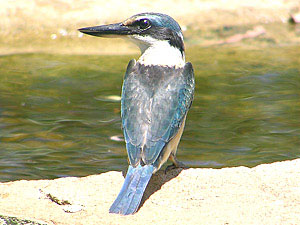
A good-looking Sacred Kingfisher. They can
vary tremendously in colour from
an aqua green, through to the blue on this bird.
|
|
|
|
|
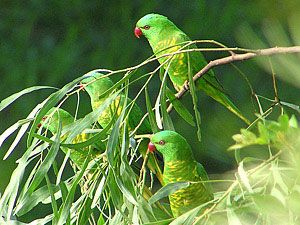
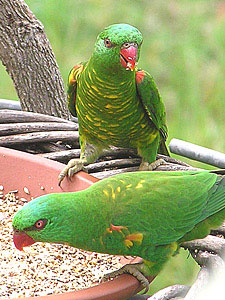
|
Scaly-breasted Lorikeets flash by most days,
but over the last week or so
they've been spending some time in the garden.
|
|
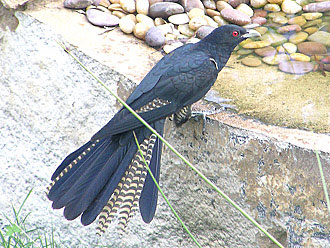
click image to enlarge
Nearly adult male Common Koel at the rock pool
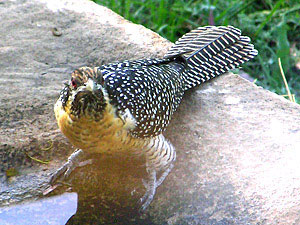
- and a female

Two young Dollarbirds braving the elements
|
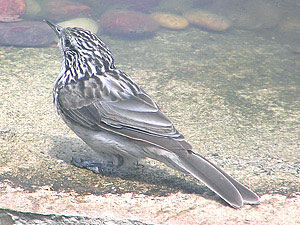
Striped Honeyeater
|
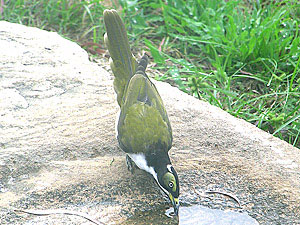
Juvenile Blue-faced Honeyeater
drinking at the rock
|

Adult Blue-faced Honeyeater
taking a sip from a birdbath
|
|

A Pale-headed Rosella making its way to the rock pool
via one of the melaleuca rails
I've erected nearby to provide birds with a comfortable
"stepping-stone"
to the pool while we wait for the new shrubs around the rock to mature.
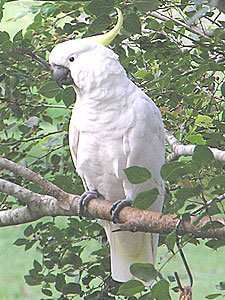
Sulphur-crested Cockatoos drop in every afternoon at a friend's house
|

Striped Honeyeater and Little Friarbird
- giving a good view of the size differential between these two honeyeaters
|
|
|
